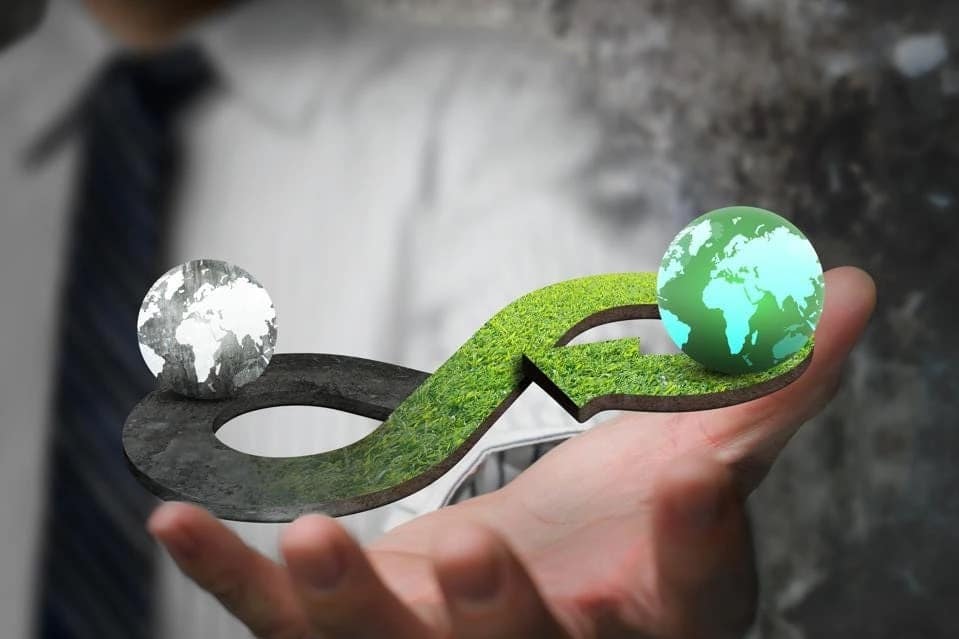Traditional take-make-dispose business models have built our economy and enabled our modern lifestyle. But to stand a chance of arresting the current climate emergency we need to embrace circular principles.
Traditional take-make-dispose business models have built our economy and enabled our modern lifestyle. But to stand a chance of arresting the current climate emergency we need to embrace circular principles.
In a world where resource extraction and use accounts for 70 per cent of all greenhouse gas emissions, where more than 91 per cent of what we take from mother Earth is wasted, and where nearly half of all emissions come from the way we make and use things, it’s no wonder we’re facing some consequences. A three-to-six-degree global temperature increase by 2044 is likely just one of those consequences.
It’s easy to feel overwhelmed, but to make change we must focus on what we can achieve and influence, and cultivate a can-do attitude to problem solving. So, let’s look at a success story. In Denmark, for example, 12 industrial partners across renewables, fossil fuels, biotech, pharmaceuticals and glass collaborate to share more than 25 different resource streams and turn each other’s waste and by-products into inputs – saving €24 million and reducing emissions by 635,000 tons of CO2 each year, among other benefits.
Indeed, evidence is mounting that dealing with our climate crisis will require considered and circular movements of raw materials to minimise waste and emissions. And yet, most industries remain stubbornly attached to linear make-use-dispose models that date back to the Industrial Revolution. It’s time to embrace a better way.
Enter the circular economy.
At its core, a circular economy enables the output of one process to become the input for another – so we can reuse resources and minimise waste. Circularity keeps materials in use for as long as possible, reducing the need for virgin materials, which benefits the environment and companies’ bottom lines.
Implementing this approach, however, requires a shift in thinking – breaking up with the linear, consumption-based treadmill and reconsidering how we view “waste.” It’s time to prioritise reusing what still works, repairing what’s broken and recycling what can’t be repurposed of repaired.
These ideas are not new. Think ‘cradle-to-cradle’ design, biomimicry and industrial ecology – we have known for some time that the natural world deals with waste with much more elegance. It’s not a far stretch of the imagination, then, that emulating these ideas in our supply chains stands to help with sustainability outcomes.
At the end of the day, circularity and reaching net zero go hand in hand. It allows us to satisfy societies’ needs while minimising waste and reducing greenhouse gas emissions. In fact, it’s hard to imagine reaching the Paris Agreement goal of keeping global warming to 1.5 degrees above pre-industrial levels without it.
In the lead up to the Paris Agreement, a study of several European nations found that a shift to a circular economy could reduce each nation’s greenhouse-gas emissions by up to 70 per cent while growing its workforce by about 4 per cent. That sounds like a win-win.
Sustainability is only one opportunity for value creation through circularity. In essence, the circular economy arrests value leakage, opening up a plethora of new business models and jobs concerned with transforming products to services and creating new markets that enable reuse.
Capital equipment, for example, consumes half of all metals worldwide. Circularity presents an opportunity to reduce waste and recover the remaining value of surplus capital equipment. Take subsea oil and gas equipment as an example – there is a lot of infrastructure in our oceans used to extract oil and gas. Apart from the fact that the world is transitioning away from fossil fuels, what happens when the field stops producing? What do we do with billions of dollars of decommissioned specialist equipment? For now, much of it ends up in landfill or at the scrapyard (or stays put, as, well, seafill). But with circularity on the rise, there’s a global market emerging for repurposed, decommissioned equipment from offshore oil and gas operations.
Beyond the world of oil and gas, however, making the transition to a circular economy is largely dependent on the push of regulation and the pull of new markets. And there is plenty of both emerging. But ultimately, what’s required is a mindset shift.
Circularity is only possible when we collaborate with supply chain partners across industries to manage waste; we need to ask questions about assets’ end-of-life scenarios and consider reuse and repurpose applications right off the bat.
The resource sector is under increasing pressure to respond to global change challenges with true, meaningful action, not just a token effort. It’s time to step off that linear treadmill and, well, start running around in circles.

